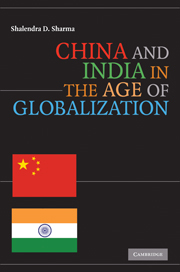Book contents
- Frontmatter
- Contents
- Acknowledgments
- Acronyms
- Political Map of China
- Political Map of India
- Introduction: China and India in the Age of Globalization
- 1 Prelude to Globalization: China (1949–1978) and India (1947–1991)
- 2 China and India Embrace Globalization
- 3 China: Strategies and Patterns of Global Integration
- 4 India: Strategies and Patterns of Global Integration
- 5 Sino-Indian Relations: Partners, Friends, or Rivals?
- 6 India and the United States: From Estrangement to Engagement
- 7 The Rise of China and Its Implications for the United States
- 8 China and India: Future Challenges and Opportunities
- Bibliography
- Index
5 - Sino-Indian Relations: Partners, Friends, or Rivals?
Published online by Cambridge University Press: 22 January 2010
- Frontmatter
- Contents
- Acknowledgments
- Acronyms
- Political Map of China
- Political Map of India
- Introduction: China and India in the Age of Globalization
- 1 Prelude to Globalization: China (1949–1978) and India (1947–1991)
- 2 China and India Embrace Globalization
- 3 China: Strategies and Patterns of Global Integration
- 4 India: Strategies and Patterns of Global Integration
- 5 Sino-Indian Relations: Partners, Friends, or Rivals?
- 6 India and the United States: From Estrangement to Engagement
- 7 The Rise of China and Its Implications for the United States
- 8 China and India: Future Challenges and Opportunities
- Bibliography
- Index
Summary
The April 2005 visit by Chinese Prime Minister Wen Jiabao and the November 2006 visit by President Hu Jintao to India, as well as the return visit by Indian Prime Minister Manmohan Singh to China in January 2008, mark an unprecedented level of interaction and dialogue between the leadership of China and India and signal a qualitative transformation in Sino-Indian relations. Following the 1962 border war, relations between the two Asian giants became estranged and increasingly acrimonious, with both sides feeling no compunction about conjuring up rather incongruous images of the other. In the shrill postwar atmosphere, each saw the other as a strategic adversary and used various strategies (e.g., China's unconditional support of Pakistan and India's close alliance with the USSR) to undermine the other's perceived designs (Sidhu and Yuan 2003). However, Prime Minister Rajiv Gandhi's (1984–88) historic visit to Beijing in December 1988 (the first such trip by an Indian leader since Jawaharlal Nehru's in 1954), followed by more high-level visits by both countries over the next several years, set in motion the process of rapprochement, the “thawing of relations,” and de-escalation of tensions. In fact, during the signing of the landmark Strategic and Cooperative Partnership for Peace and Prosperity in 2005 both sides effusively described their relations as “warm and friendly.”
The improvement in Sino-Indo relations has also resulted in growing economic linkages between the two countries.
- Type
- Chapter
- Information
- China and India in the Age of Globalization , pp. 164 - 184Publisher: Cambridge University PressPrint publication year: 2009

